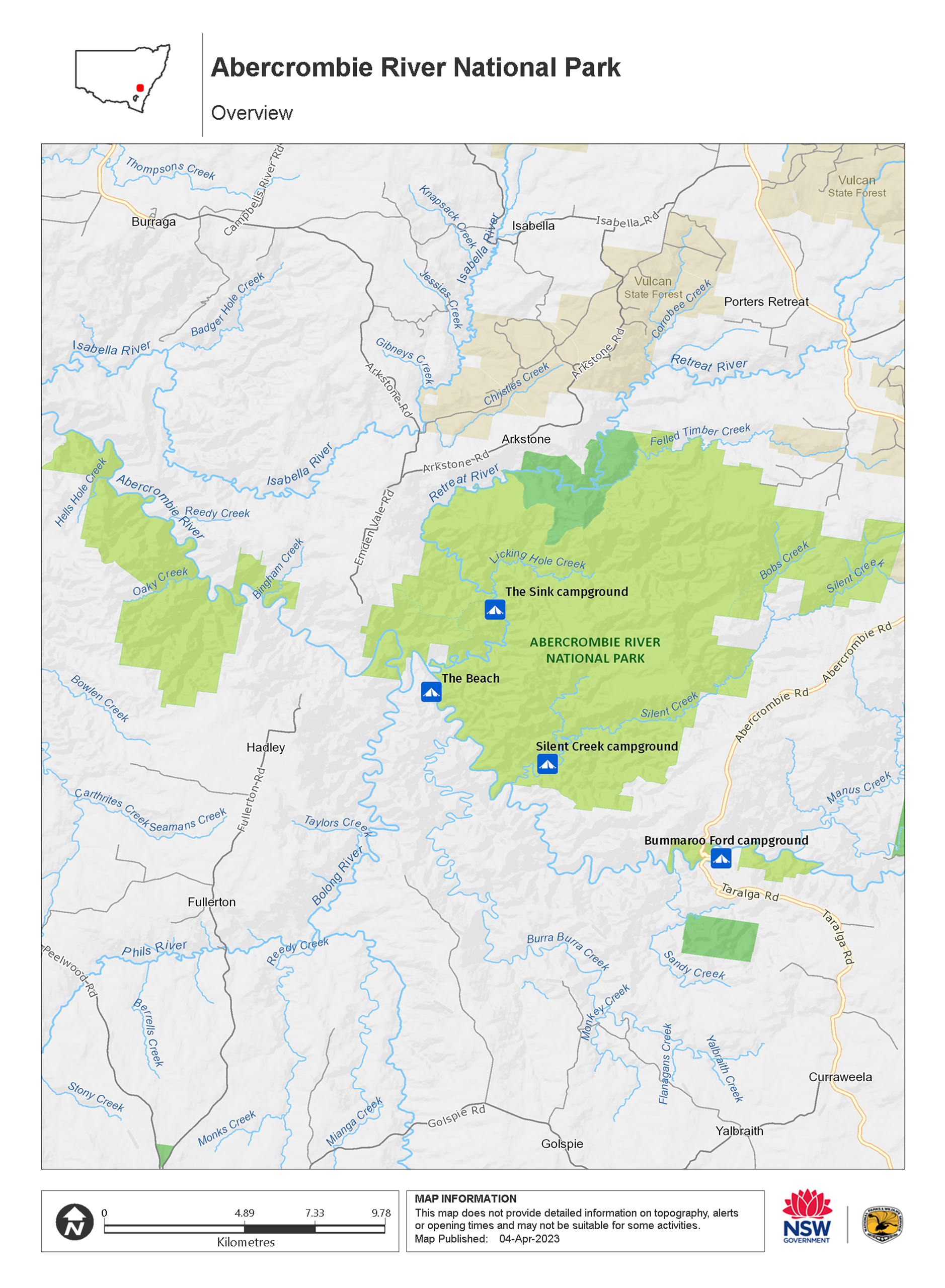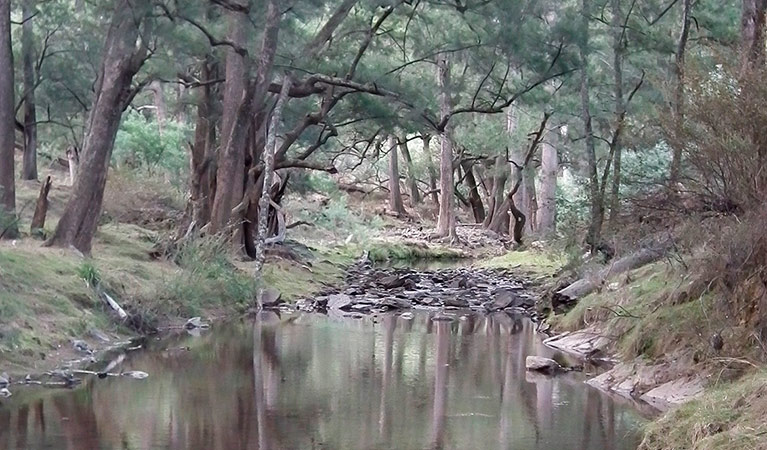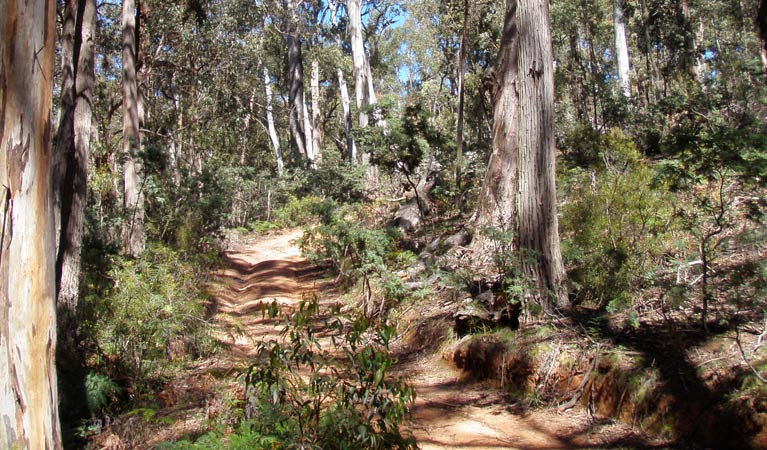Abercrombie River National Park
Open, check current alerts
Overview
Ideal for 4WD adventures, Abercrombie River National Park gives visitors opportunities for 4WD touring, hiking, camping, birdwatching and swimming in its 3 waterways and open forests.
Read more about Abercrombie River National Park
You can follow fire trails, seek out swimming, canoeing and trout fishing spots, and explore the waterways. Or hunt out Licking Hole and discover an abandoned goldminer's cottage. Relics of the 19th century gold rush – diggings, water races and sluices – can also be found along the riverbanks.
And at the end of the day, relax and refresh at any of the 4 camping sites: Bummaroo Ford, Silent Creek, The Beach and The Sink.
If you don't have a 4WD, don't worry. Bummaroo Ford can be accessed by 2WD and offers easy access to hikes along the Abercrombie River, canoeing, kayaking and family-friendly camping.
Abercrombie River National Park isn't just a paradise for adventurers though, it's also great for nature lovers. Gazetted in 1995, the park protects the largest intact patch of open forest on the NSW Central Tablelands. In the high north of the park you'll find dense mountain gum forests, while in the south you can explore open forests of scribbly gum and stringy bark. Wallabies, kangaroos and emus can be seen year-round, and at dawn or dusk you may even spot platypuses at isolated waterholes.
Local alerts
For the latest updates on fires, closures and other alerts in this area, see https://www.nationalparks.nsw.gov.au/visit-a-park/parks/abercrombie-river-national-park/local-alerts
Map

Map legend

Contact
- in the Sydney and surrounds and Country NSW regions
Abercrombie River National Park is always open but may have to close at times due to poor weather or fire danger.
-
-
Oberon office
02 6336 6200
Contact hours: Monday to Friday, 9am to 4.30pm. - 38 Ross Street, Oberon NSW 2787
-
Email: npws.kanangra@environment.nsw.gov.au
-
Oberon office
Visitor info
All the practical information you need to know about Abercrombie River National Park.
Getting there and parking
Get driving directions
From Goulburn:
- The main access to the park is via the Arkstone Road. Turn onto the Arkstone Road from the Oberon-Goulburn Road, 7km south of Black Springs. This area of the park is accessible by 4WD only, in all weather.
- You can also get to the park via Felled Timber Road and Brass Walls Fire Trail (4WD access, during dry weather only). Turn off the Oberon-Goulburn road onto Felled Timber Road about 23km south of Black Springs.
- 2WD can access Bummaroo Ford along the sealed Abercrombie Road (Oberon-Goulburn Road). Bummaroo Ford is situated on the Abercrombie River, 33km north from Taralga and 74km south from Oberon.
By bike
Check out the Bicycle information for NSW website for more information.
By public transport
For information about public transport options, visit the NSW country transport info website
Best times to visit
There are lots of great things waiting for in Abercrombie River National Park. Here are some of the highlights.
Spring
The weather at this time of year is perfect for camping and hiking.
Summer
Bring your swimmers and take a dip in Abercrombie and Retreat rivers.
Winter
The days are crisp – snow falls in higher parts of the park – so pack on the layers, fire up the 4WD and explore some of those trails.
Weather, temperature and rainfall
Summer temperature
Average
9°C and 25°C
Highest recorded
34.5°C
Winter temperature
Average
0°C and 11°C
Lowest recorded
–10.5°C
Rainfall
Wettest month
June
Driest month
March
The area’s highest recorded rainfall in one day
200.3mm
Facilities
Toilets
Barbecue facilities
Maps and downloads
Prohibited
Pets
Pets and domestic animals (other than certified assistance animals) are not permitted. Find out which regional parks allow dog walking and see the pets in parks policy for more information.
Smoking
NSW national parks are no smoking areas.
Nearby towns
Oberon (52 km)
If the famous Jenolan Caves are on your travel itinerary Oberon in the Blue Mountains is the perfect spot from which to plan your caving adventure. There are a number of ways visitors can tour the caves.
Taralga (88 km)
Many of Taralga's existing buildings date from the 1860s to the 1890s, and most of them consist of stone from local volcanic supplies. This has resulted in an architectural style unique to Taralga that is somewhere between Georgian and Victorian, giving the town a unique and picturesque aesthetic.
Goulburn (134 km)
Named after Henry Goulburn - the British Secretary of State for the Colonies, Goulburn developed into a major centre for wool, and in 1863, it became Australia's first inland city. Today, the town is a rich hub of history, discovery and natural beauty.
Learn more
Abercrombie River National Park is a special place. Here are just some of the reasons why:
Wild kingdom

All year round, this is a great spot to observe local wildlife. Kangaroos, wallabies and emus are seen throughout the park, and echidnas and wombats live on the slopes and river flats. The rivers and creeks are home to eastern water dragons and the shy platypus. In summer, you’ll hear the sound of frogs calling out near the creeks. There are also more than 60 species of birds around here – look for wedge-tail eagles soaring above Abercrombie trail.
Gold standard

Landscapes of deep gullies with rivers running through them – such as the one found at Abercrombie River – provide ideal conditions for loose gold. During the gold rush of the second half of the 1800s, the precious mineral was discovered here. Following the rivers and creeks you can find evidence – sluices and diggings – still there today.
Action-ready

This is an environment built for adventure. One of the most popular activities in the park is 4WD touring. Some of the trails running along gorges and ridges can be pretty challenging, even for the experienced driver. For those with plenty of energy, you can also explore these trails on a mountain bike. The rivers and creeks, shaded by tall casuarinas, have plenty of deep waterholes. Pull on your swimmers and jump on in. Or perhaps you’ve got a canoe or kayak – bring it along because there are some good stretches for paddling.
Aboriginal culture

The ridgelines and rivers running through Abercrombie River National Park were once traditional travel and trading routes for the Wiradjuri and Gundungarra People. Evidence of open campsites can be found along the rivers and creeks in the park.
Plants and animals protected in this park
Animals
-

Swamp wallaby (Wallabia bicolor)
The swamp wallaby, also known as the black wallaby or black pademelon, lives in the dense understorey of rainforests, woodlands and dry sclerophyll forest along eastern Australia. This unique Australian macropod has a dark black-grey coat with a distinctive light-coloured cheek stripe.
-

Bare-nosed wombat (Vombatus ursinus)
A large, squat marsupial, the Australian bare-nosed wombat is a burrowing mammal found in coastal forests and mountain ranges across NSW and Victoria. The only other remaining species of wombat in NSW, the endangered southern hairy-nosed wombat, was considered extinct until relatively recently.
-

Common ringtail possum (Pseudocheirus peregrinus)
Commonly found in forests, woodlands and leafy gardens across eastern NSW, the Australian ringtail possum is a tree-dwelling marsupial. With a powerful tail perfectly adapted to grasp objects, it forages in trees for eucalypt leaves, flowers and fruit.
Environments in this park
What we're doing
Abercrombie River National Park has management strategies in place to protect and conserve the values of this park. View the detailed park and fire management documents. Here is just some of the work we’re doing to conserve these values:
Managing weeds, pest animals and other threats
Pests and weeds have a significant impact to the ecosystems within Abercrombie River National Park. Risk assessments for new and emerging weeds are carried out as an ongoing initiative within the park. Pest reduction of wild dogs is an important part of the work NPWS does to protect the integrity of biodiversity which exists within Abercrombie.
Managing fire
NSW is one of the most bushfire prone areas in the world as a result of our climate, weather systems, vegetation and the rugged terrain. NPWS is committed to maintaining natural and cultural heritage values and minimising the likelihood and impact of bushfires via a strategic program of fire research, fire planning, hazard reduction, highly trained rapid response firefighting crews and community alerts.

